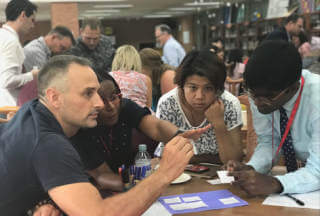"Teaching is subordinate to learning" Caleb Gattegno
Building Background simply means preparing students for what they are about to learn. In a way, this component is all about starting where the students are, not where they aren't. SIOP examines this through the lens of both content and language.
This component of SIOP encourages teachers to consciously try and connect students to both the content and language of the lesson. Teachers build background by helping students connect the know to the unknown and the old to the new. The three features (below) remind educators of three important factors: First, helping students focus on the familiar first is a good place to start. Next, students come with valuable knowledge and skills that need to be used. Finally, vocabulary must be a conscious, sustained effort. Once again, SIOP helps teachers consciously attend to language.

The amount of time that a teacher may spend building background depends on how foreign the content and language are to the students. Talking about living in an igloo to a Polynesian student body may take some background building. Likewise, the idea of emphasizing vocabulary may take a little or a lot of effort depending on a variety of factors. Some students may not need a lot of it while others may need a significant amount of support. That's why we teachers much consciously attend to it.
Making vocabulary a focus of your class does not have to take away from learning; rather it should enhance it. As teachers, we must learn to emphasize important vocabulary and key terminology at the beginning, the middle, and the end of our lessons. This, however, does not have to consume vast amounts of time.
Here are 5 things to remember about emphasizing key vocabulary.
How important is oral language development when it comes to vocabulary development? As John Kongsvik says, "if it comes out of the mouth, it comes out of the pen; if it doesn't come out of the mouth, it will never come out of the pen."

While students can gain a tremendous amount from a few building background activities (see SIOP feature 7 and SIOP feature 8), teachers also get a lot out of these activities. Beyond having students that are more prepared to learn, teachers also have a chance to informally assess where students stand with the lesson's objectives. This not only helps teachers get a preview of what might be easy or difficult for the students, it also helps them make adjustments to the lesson before getting deep into it.
The more work teachers put into building background, the more comfortable students will feel with the content and language. Also, the more risks students will tend to take if they know what is coming. This can be especially beneficial to English learners who may lack the comfort with the language. Consciously connecting students to the lesson's content and language pays many dividends.
There are plenty of reasons to invite TESOL Trainers to provide professional development on SIOP to your teaching staff. Here are four of the most powerful:
TESOL Trainers offers world class remote professional development to K12 teachers. We have a host of programs that can support teaching and learning. Whether you want assistance with SIOP, vocabulary teaching techniques, TESOL Strategies, or online teaching techniques, we can give you remote teacher training sessions that will transform your teachers and their learners.
Click the button below to claim your free ebook and join our mailing list.